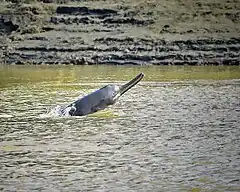| Platanistidae | |||
| J.E. Gray, 1846[1] | |||
 Przedstawiciel rodziny – suzu gangesowy (Platanista gangetica) | |||
| Systematyka | |||
| Domena | |||
|---|---|---|---|
| Królestwo | |||
| Typ | |||
| Podtyp | |||
| Gromada | |||
| Podgromada | |||
| Infragromada | |||
| Rząd | |||
| Podrząd | |||
| Infrarząd | |||
| Parvordo | |||
| Nadrodzina | |||
| Rodzina |
suzowate | ||
| Typ nomenklatoryczny | |||
|
Platanista Wagler, 1830 | |||
| Synonimy | |||
|
| |||
| Rodzaje | |||
| |||
Suzowate[8] (Platanistidae) – rodzina wodnych ssaków z parvordo zębowców (Odontoceti) w obrębie infarzędu waleni (Cetacea). W odróżnieniu od większości delfinów żyją w wodach o niskim zasoleniu, jak rzeki i jeziora, czasami w głębi lądu.
Systematyka
Do rodziny Platanistidae należy jeden występujący współcześnie rodzaj[9][10][8]:
oraz rodzaje wymarłe:
- Araeodelphis R. Kellogg, 1957[11] – jedynym przedstawicielem był Araeodelphis natator R. Kellogg, 1957
- Dilophodelphis Boersma, McMurry & Pyenson, 2017[12] – jedynym przedstawicielem był Dilophodelphis fordycei Boersma, McCurry & Pyenson, 2017
- Pachyacanthus Brandt, 1871[13] – jedynym przedstawicielem był Pachyacanthus suessii Brandt, 1871
- Pomatodelphis G.M. Allen, 1921[14]
- Prepomatodelphis L.G. Barnes, 2006[7] – jedynym przedstawicielem był Prepomatodelphis korneuburgensis Barnes, 2002
- Zarhachis Cope, 1868[15]
Uwagi
Przypisy
- 1 2 J.E. Gray: The zoology of the voyage of the H.M.S. Erebus & Terror, under the command of Captain Sir James Clark Ross, during the years 1839 to 1843. Cz. 1: Mammalia, Birds. London: E. W. Janson, 1846, s. 48. (ang.).
- ↑ J.E. Gray: Catalogue of seals and whales in the British Museum. Wyd. 2. London: The Trustees, 1866, s. 62. (ang.).
- ↑ W.H. Flower. Description of the Skeleton of Inia geoffrensis and of the Skull of Pontoporia blainvillii, with Bemarks on the Systematic Position of these Animals in the Order Cetacea. „Transactions of the Zoological Society of London”. 6, s. 114, 1867. (ang.).
- ↑ J.E. Gray: Synopsis of the species of whales and dolphins in the collection of the British Museum. London: B. Quaritch, 1868, s. 4. (ang.).
- ↑ G.G. Simpson. The principles of classification and a classification of mammals. „Bulletin of the American Museum of Natural History”. 85, s. 100, 1945. (ang.).
- ↑ P. Hershkovitz. On the nomenclature of certain whales. „Fieldiana Zoology”. 39 (49), s. 555, 1961. (ang.).
- 1 2 L.G. Barnes. An Early Miocene long-snouted marine platanistid dolphin (Mammalia, Cetacea, Odontoceti) from the Korneuburg Basin (Austria). „Beiträge zur Paläontologie”. 27, s. 411, 2002. (ang.).
- 1 2 Nazwy zwyczajowe za: W. Cichocki, A. Ważna, J. Cichocki, E. Rajska-Jurgiel, A. Jasiński & W. Bogdanowicz: Polskie nazewnictwo ssaków świata. Warszawa: Muzeum i Instytut Zoologii PAN, 2015, s. 190. ISBN 978-83-88147-15-9. (pol. • ang.).
- ↑ N. Upham, C. Burgin, J. Widness, M. Becker, C. Parker, S. Liphardt, I. Rochon & D. Huckaby: Treeview of Mammalian Taxonomy Hierarchy. [w:] ASM Mammal Diversity Database (Version 1.11) [on-line]. American Society of Mammalogists. [dostęp 2023-01-23]. (ang.).
- ↑ C.J. Burgin, D.E. Wilson, R.A. Mittermeier, A.B. Rylands, T.E. Lacher & W. Sechrest: Illustrated Checklist of the Mammals of the World. Cz. 2: Eulipotyphla to Carnivora. Barcelona: Lynx Edicions, 2020, s. 288. ISBN 978-84-16728-35-0. (ang.).
- ↑ R. Kellogg. Two additional Miocene porpoises from the Calvert Cliffs, Maryland. „Proceedings of the United States National Museum”. 107, s. 313, 1957. (ang.).
- ↑ A.T. Boersma, M.R. McCurry & N.D. Pyenson. A new fossil dolphin Dilophodelphis fordycei provides insight into the evolution of supraorbital crests in Platanistoidea (Mammalia, Cetacea). „Royal Society Open Science”. 4 (5), s. 170022, 2017. DOI: 10.1098/rsos.170022. (ang.).
- ↑ J.F. von Brandt. Bericht uber den Fortgang meiner Studien uber di Cetaceen, welche das grosse zur Tertiarzeit von Mitteleuropa bis Centralasien hinein ausgedehnte Meeresbechen bevolkerten. „Bulletin de l’Académie impériale des sciences de St.-Pétersbourg”. 16, s. 564, 1871. (niem.).
- ↑ G.M. Allen. Fossil Cetaceans from the Florida Phosphate Beds. „Journal of Mammalogy”. 2 (3), s. 148, 1921. DOI: 10.2307/1373603. (ang.).
- ↑ E.D. Cope. Second contribution to the History of the Vertebrata of the Miocene period of the United States.. „Proceedings of the Academy of Natural Sciences of Philadelphia”. 20, s. 189, 1868. (ang.).
Identyfikatory zewnętrzne:
This article is issued from Wikipedia. The text is licensed under Creative Commons - Attribution - Sharealike. Additional terms may apply for the media files.